Job interviews are not easy. If you want to apply for...


Few residents of the country can afford to use natural stone for finishing work. Needless to say, pleasure is not cheap. In addition, it is also extremely difficult to select a sufficient amount of material of the same tone for personal needs.
Recently, the topic is manufacturing.
With a serious approach to business, you can start the production of artificial marble on your own.
Most often, artificial marble is produced in three main types:
- based on concrete;
- based on polyester resins;
- based on gypsum.
For a decorative effect, artificial marble is coated with a gel coat, while the filler consists of mineral chips, resins and pigments and hardeners. The appearance of cast marble as a whole will depend on the color of the gelcoat. When using a clear gelcoat, the color will be determined by the pigment or filler added to the polyester resin.
It is polyester resin that is a binder for the cast type of marble, to which a filler in the form of mineral chips is added. The size of the fractions and the amount of mineral filler depends on the desired end result.
Thanks to a certain technique, during the production process, when mixing the components, stains and stains are obtained, similar to natural marble.
The resulting building material is not combustible; interferes with the conduction of electricity. The homogeneity of the material structure, resistance to corrosion and alkaline environments are noted.
How to make artificial marble based on concrete? Everything is simple. Use a building mixture of crushed stone, river sand or pebbles. Additionally, you need to prepare construction equipment: a matrix or a polyurethane form; mixer; gelcoat, brush
Concrete-based technology involves the preparation of a working composition, strictly following the proportions of cement, sand and filler. A plasticizer, dyes and 80% liquid are added to the base materials. Using a mixer, a plastic mass is obtained. The remaining 20% water is then added, mixed again and spread over the polyurethane molds.
 Forms must be clean, dry, pre-treated with gel coat. After evenly distributing the mixture in the matrix, removing excess solution, cover the form with a film specially designed for this. After a 10-hour exposure of the working mixture, a ready-made monolith of artificial marble is removed from the mold.
Forms must be clean, dry, pre-treated with gel coat. After evenly distributing the mixture in the matrix, removing excess solution, cover the form with a film specially designed for this. After a 10-hour exposure of the working mixture, a ready-made monolith of artificial marble is removed from the mold.
From all of the above, it follows that it is not so difficult to make artificial marble with your own hands.
The process of preparing artificial marble from gypsum is as follows: gypsum powder, wood glue are added to the specified amount of water; as well as resin, previously melted in hot turpentine. After thorough mixing of these components, pigment or acrylic dyes are added to the mixture. With their help, the desired patterns are obtained from divorces.
It is known that, using various coloring pigments, it is possible to obtain the desired shade of artificial marble from gypsum. So, to obtain a milky tone of marble, you need to add 200 grams of white humilax and 50 grams of gypsum powder per 1000 grams of technical alcohol. If it is necessary to obtain brown tones of artificial marble, orange humilax must be used, and accordingly, aniline paint is used for black or dark gray polish.
The liquid substance of the mixture is poured into a special polyurethane mold, sprinkled with gypsum powder on top, and left to harden for 10 hours. After the specified time, artificial marble from plaster is carefully removed from the mold. In order for the surface to be waterproof and more practical, it should be treated on the front side with potassium silicate.
If necessary, the semi-finished product is immersed in the bath and processed on both sides. After the surface is completely dry, it should be treated with a soft felt material or a special abrasive material with colored polish. With this treatment, they strive for a perfectly smooth surface.
Based on the review, it can be concluded that the use of artificial marble is currently economically viable.
Such material can withstand significant loads. It has low thermal conductivity. If there is a mechanical damage to an artificial marble product, it is possible to restore its former shape. In everyday life, artificial marble surfaces are quickly cleaned of lipstick, tea, coffee, red wine, tomato juice etc. The main care for the work surface made of artificial marble is to polish it with a special paste using a felt nozzle on a drill.
artificial marble has the hardness inherent in natural stone, easy to process, which allows you to give the product the desired shape. Artificial marble is warm, pleasant to the touch, has a high resistance to wear. The main advantage is that its production can be carried out at home, it is enough to carefully study the manufacturing technology of an excellent substitute for natural marble from concrete.
There are natural and unnatural. Artificial material is called a material obtained from concrete. It differs little from natural stone. The production technology is different. Depending on this, the following types of artificial stone are distinguished:
This article discusses the latter type.
This material is most often used for exterior cladding of buildings. It is used as an alternative ceramic tiles for bathrooms, flooring, countertops for kitchen tables, sinks and sinks, steps, and sculptures, bank, office and bar counters, fireplaces and many other items. Fireplaces are decorated with this material, serving as a hearth of comfort in the house, and recently - a sign of prosperity and luxury. Artificial marble made of concrete, wherever it is applied, is a sign of exquisite taste.
Decorative concrete, artificial marble, colored concrete, artificial stone, decorative marble are the same material, the production basis of which is a cement-sand mixture, which is characterized by high qualities. Products from it have a highly artistic appearance.
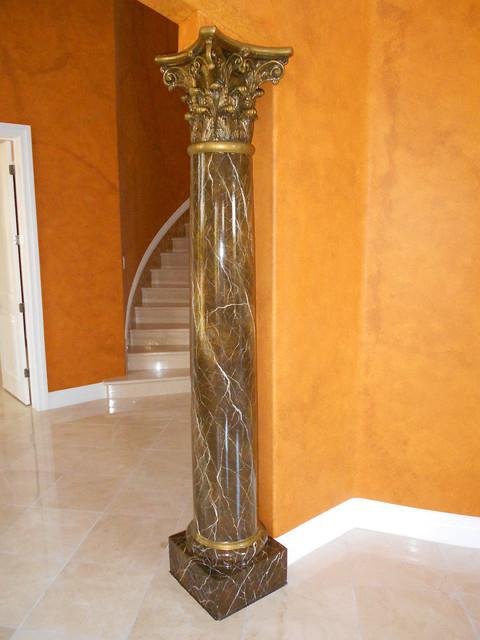
So, marble made of concrete has found the widest application in the production of construction and facing works.
Marble is a special natural material that gives grandeur and beauty to any structure. Recently, it is often used in the interior of the house. But natural stone is expensive, not everyone has the opportunity to purchase it. Therefore, experts have developed a technology for the production of artificial marble from concrete, the appearance and quality of which are identical to natural stone, which has the following advantages:
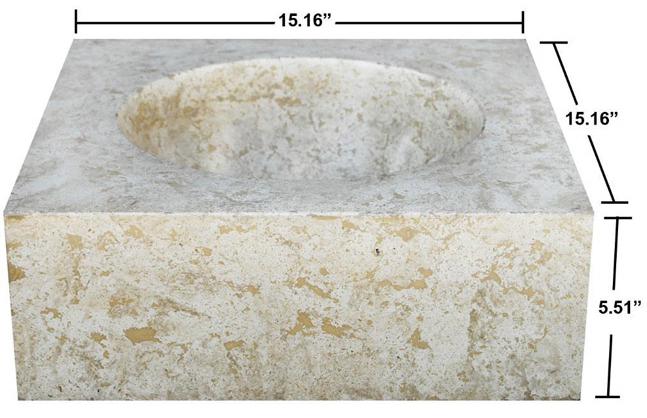
To make marble from concrete with your own hands at home, you need to stock up:
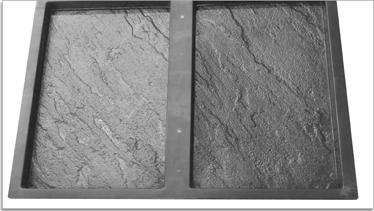
After preparing all the necessary materials, you can safely get to work. The production of marble from concrete begins with the preparation of the mortar. It should be mixed in a ratio of 1:3. The best filler is small pebbles. Although other additives can be used: expanded clay, ceramic chips, pumice.
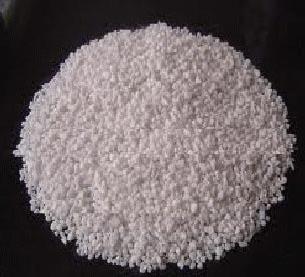
Technology marble from concrete provides for the following steps:

Recently, the use of stone as a finishing material has gained wide popularity. But building materials such as, for example, marble or natural granite are not always affordable for us (prices bite). But why pay more, and besides, why waste your nerves and time when choosing, when there is an option to create artificial marble with your own hands at home?
Artificial marble has long been used for the manufacture of items such as sinks, window sills, countertops, countertops and much more. A huge plus of this material is that it is very easy to work with, which explains such a widespread use in marble finishing. All we need before making artificial marble with our own hands is to prepare a mold for casting the part.
Artificial marble is a simple combination of acrylic resin with mineral filler. This material is easily comparable in hardness to natural stone, and it is very easy to process, it can take absolutely any shape. Also, quite a big plus of artificial stone from natural is warmth, it is warm and pleasant to the touch. By the way, in terms of wear resistance, artificial material is in no way inferior to natural.
Artificial marble is based on polyester resins. They are the main element of the strength of this unique material. The composition also includes fillers and color pigments (dyes). With the right mixing of dyes, we get the so-called marble effect on the material (imitated veins, stains, spots). Also during the production of artificial marble, you can achieve any color of the material.
Uniqueness of artificial marble:
All these uniquenesses provide this product with the widest range of applications in any field of activity.
First of all, for the manufacture of artificial marble with your own hands, allocate a separate room, since the manufacturing method involves working with chemicals. Choose a place where there is more space to place the forms, so as not to feel cornered, but to feel free.
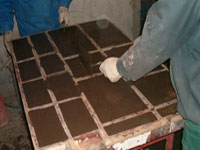 1.
Before proceeding directly to the manufacturing technology of the product, check the list of all components for the manufacture of marble: a polyurethane matrix for the finished product, two parts of sand (river). One part of cement, water 0.2 parts, dye (calculated approximately one percent of the cement), pebbles for filling, plasticizer (calculated as dye, one percent of the cement weight), mixer and film (cellophane).
1.
Before proceeding directly to the manufacturing technology of the product, check the list of all components for the manufacture of marble: a polyurethane matrix for the finished product, two parts of sand (river). One part of cement, water 0.2 parts, dye (calculated approximately one percent of the cement), pebbles for filling, plasticizer (calculated as dye, one percent of the cement weight), mixer and film (cellophane).
2. First, molds are made for the future product. They must not be dirty or wet. It will also be necessary to prepare a mixture for manufacturing in advance, for this we take and mix cement, sand and pebbles. We mix until all this dry mass becomes homogeneous, until everything acquires one color, after thorough mixing we add dyes, due to which artificial marble becomes similar to natural marble stone, veins, spots and stains appear.
In this case, the quote makes sense: “the worse, the better”, the nature of artificial marble and a higher similarity with natural one depend on the uneven placement of the dye in the mass.
3. The moment comes to add water to this bulk mass, add about 0.8% plus a plasticizer and mix thoroughly. After some time of mixing, the mixture becomes plastic, it is then that all the rest of the water prepared for the manufacture of the product should be poured. Now we take the mixer and mix it all thoroughly, it is this moment that needs special attention, since the quality of the marble depends on the uniformity of this mass.
4. We place the prepared mixture at home in a pre-prepared form of the part, when placing the mixture, you should try to push as much of the elastic mass as possible into the form, expelling air from there. To ensure that the porosity of the product is as low as possible and that shells do not appear after being removed from the molds directly on the surface of the product, special vibrating platforms are used in large industry for this.
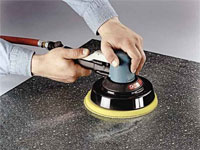 We put a mold with the mixture on the platform, and with the help of vibration the mixture is compacted, giving the product high strength and long service life. In home production, too, when filling the mold with a mixture with your own hands, it is necessary to give it vibration, only then the product will acquire high quality and the desired appearance.
We put a mold with the mixture on the platform, and with the help of vibration the mixture is compacted, giving the product high strength and long service life. In home production, too, when filling the mold with a mixture with your own hands, it is necessary to give it vibration, only then the product will acquire high quality and the desired appearance.
5. After proper filling, remove all excess from the edges of the form with a spatula and cover it with a thick plastic film. The prepared product is given time for complete hardening, this happens within ten to twelve hours. After hardening, carefully remove the film from the product and remove it from the mold.
6. Marble slabs prepared using this technology can be used for a variety of room finishes, you can also try a little and refine the product, giving it desired shape. Midday material has low porosity, so it is resistant to various types of processing and external influences.
Modern analogues of traditional natural materials are widely used today. The advantages of using artificial stone in interior design are incalculable, it is enough to mention the exceptional strength of the material and the relatively low cost.
The possibility of self-manufacturing, ease of installation and processing of the finished product, as well as the use of innovative technologies in manufacturing - all these aspects are described in detail in the information of this article.

The use of natural stone in the design of residential and public buildings has more than one hundred years of positive use. Such cladding has always been the prerogative of the upper strata of society, but with the advent of artificial analogues, such luxury has become more affordable.
You can learn about how it looks from this article.
This significantly expands the scope of use and promotes the popularization of artificial marble products.
Advantages of using artificial stone in the interior:
You can find out what it is from this article.
On the video - the technology of manufacturing artificial marble:
However, we should not forget about some of the features of this material: finished products must be appropriately certified, and when self-manufacturing, it would be useful to study the production technology in advance, stock up on all the necessary materials and tools. The manufacture of artificial marble requires compliance with safety rules, since contact with chemicals occurs during work.
Here everything is limited only by your imagination! Artificial marble is widely used as a facing material, both indoors and outdoors. Facades made of artificial marble are absolutely resistant to atmospheric phenomena, ultraviolet radiation and mechanical damage. The scope of this material is very wide, good strength and harmlessness to others will allow the material to perform a wide variety of tasks.
On the video - the use of artificial marble:
A few examples of the use of artificial stone:
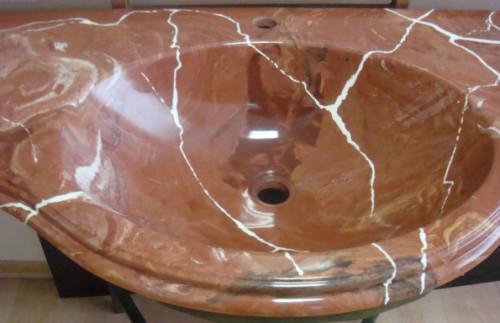
In principle, artificial stone in general and marble in particular can be used to decorate any interior detail. Depending on the type of sand, marble can form a rather thin layer, which is successfully used for interior wall covering instead of traditional wallpaper.
In order to better understand the possibility and technology of independent production of artificial marble, one should study in more detail the qualitative composition of the molding sand and the types of this material. A brief overview and a master class on making marble with your own hands - later in our article.
There are the following types of artificial marble:
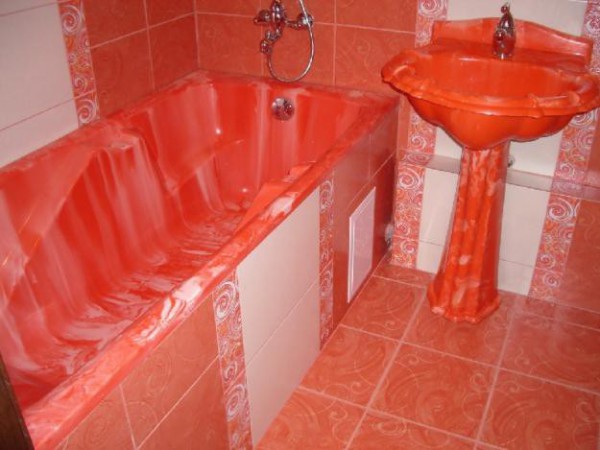
In more detail, you should familiarize yourself with the undisputed leader of this list - cast artificial marble, which, in terms of its performance and ease of manufacture, is in the greatest demand.
Cast marble contains polyester resins, mineral fillers, water and special pigments. Thanks to natural ingredients, marble is obtained with the most natural composition and excellent characteristics. Thanks to dyes, it is possible to recreate the structure of almost any natural stone, but marble imitation has gained the most popularity.
The algorithm for creating products from cast marble:
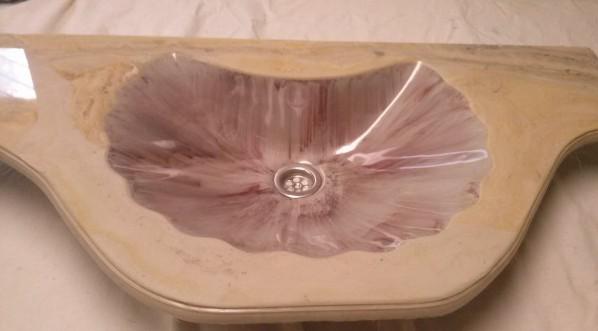
The resulting part is then subjected to grinding for the final removal of burrs and inclusions of the mixture. Also, the surface is polished with a special brush to give smoothness and visual appeal to the product.
The process of making artificial marble with your own hands is not much different from industrial method. The tool can be used the same, only expensive forms to create one product will not be worth buying. That is why there are many ways to make matrices yourself.
Usually, plastic containers of a suitable size and configuration are used for this. For the manufacture of a conventional plate, a wooden pallet with folding sides will be quite enough. Dimensional accuracy will not be so important, because the finished product can be cut to the required dimensions.
The presence of a vibrating table will greatly facilitate the task and make the structure of the artificial stone more durable and uniform, but for lack of a better one, you can use the manual mixing method. A layer of gelcoat can also be applied with a hand spray gun or a conventional paint brush. In general, any home master may well independently choose how to replace industrial equipment with him. Special mixing containers can be successfully replaced with a mixer attachment for an electric drill. The top layer of the homemade form is insulated with a plastic film for successful removal from the frozen mass. 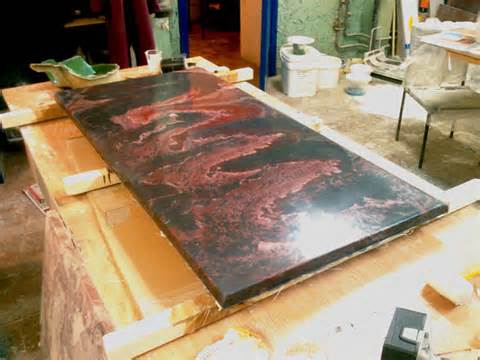
Artificial marble is an excellent finishing material that is widely used in everyday use. It is used for aesthetically attractive and durable cladding of interior walls and exterior facades of buildings.
On video -
Floor tiles made of this material are extremely resistant to abrasion and mechanical damage, and kitchen worktops and backsplash very successfully resist aggressive influences. temperature regime and chemicals.
Sinks made of artificial marble are distinguished by their excellent design and trouble-free operation. Self-manufacturing artificial marble will significantly reduce the cost and allow you to get original configurations and colors of finished products.
Comments:
Anyone who has taken even a minimal part in construction work is well aware that concrete is an important building material. Concrete products are used to build the foundations of buildings, floors between floors, serve as the basis for the construction of stairs. However, many do not even assume that you can make marble from concrete with your own hands. This work is simple and does not require special professional skills.
Concrete marble withstands temperature changes and retains its strength.
Marble, made of concrete, is an ideal facing material due to its properties. Products made of artificial marble are great for exterior decoration of buildings, as they perfectly withstand temperature extremes without losing their original strength.
Before making marble from concrete, you should carefully study the technology of its production, and then purchase the components necessary for manufacturing.
Regardless of the number of manufactured marble products, it is necessary to prepare a place protected from atmospheric precipitation for work. To stir the mortar, it is better to use a construction mixer, however, if the house has a powerful hammer drill, then usually there is a special nozzle included in the kit, with which it is easy to prepare a high-quality concrete mortar.
If artificial marble will be produced in solid quantities, then you will have to purchase or rent a vibrating table designed to compact the finished solution and remove air from it. In this way, a perfect adhesion of the mortar to the surface of the polyurethane mold is achieved. This procedure makes it possible to obtain a finished product with a glossy surface that does not require further processing. In the manufacture of marble products of small size, you can do without a vibrating table, replacing its work with vigorous shaking of the mold filled with mortar.
For the manufacture of artificial marble from concrete, the following materials will be required:
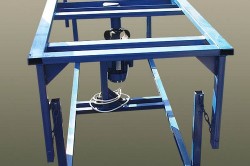
Vibrating tables come with horizontal and vertical vibration.
Of the tools needed to create marble from concrete, it should be highlighted:
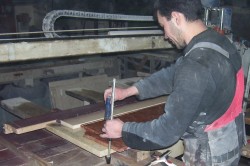
For this purpose, the prepared wire is simply embedded in the solution until it is completely frozen. Then the concrete with which the molds are filled is covered with a polyethylene film. Time of readiness of artificial marble is not less than 24 hours. During this time, the mass of concrete should completely harden. It must be borne in mind that the surface of the form must be absolutely smooth, and before pouring concrete into it, it must be installed strictly horizontally. In order for the finished product to be easily removed from the mold, it must be detachable.
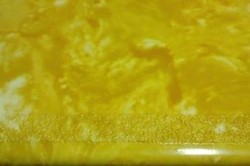
The connecting elements of the tiles are practically invisible to each other.
The main advantage of marble, for the production of which concrete is used, is the absence of the need for additional processing. Products are immediately made in the required shape and size, with a smooth surface, the pattern of which completely imitates polished natural stone. In the manufacture of tiles, used both for finishing walls, steps, and for use as a pavement cover, it is possible to give them such a shape that they will be connected to each other, creating a perfectly flat surface. The joints of such tiles will be almost invisible. The affordable cost of this wonderful finishing material for the mass consumer is also a very important reason for the high demand for products made from it. Few consumers can afford to finish the house with natural marble. It is especially difficult to choose the right shade of finish, as marble of some colors can be mined far from the construction site.
For this reason, its price becomes inaccessible to consumers with average incomes. Artificial marble gets its color from pigments added to the concrete, so getting the right shade of the product is not difficult.
A product created from artificial marble has a strength higher than natural stone, there is no waste during its creation. All components used in its production are environmentally friendly; when heated, no harmful impurities are released from them.
Those consumers who are incredulous about marble made of concrete should be reminded that the most accessible of natural materials - granite - has increased levels of radioactivity.